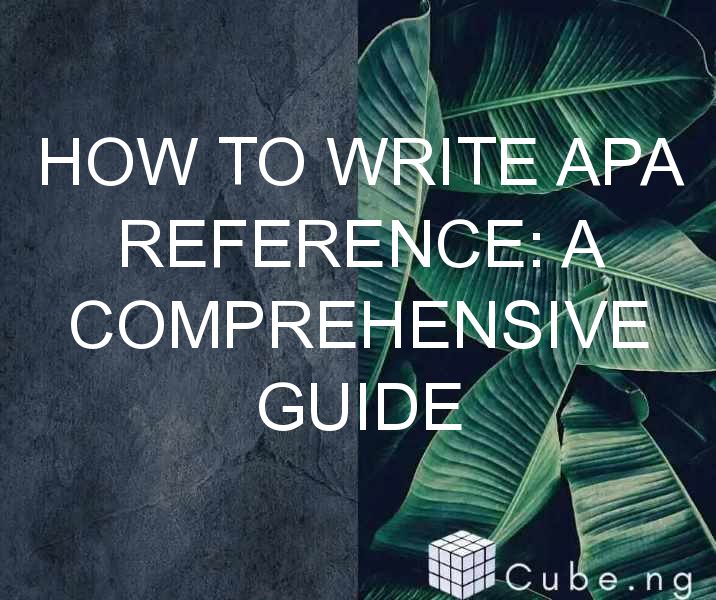If you're a student or a researcher, you're probably familiar with the American Psychological Association (APA) style of writing. This style is commonly used in social sciences, such as psychology, sociology, and anthropology. One essential aspect of the APA style is referencing. Referencing is the process of acknowledging and citing the sources you've used in your work.
In this article, we'll discuss how to write APA reference. By the end of this guide, you'll have a clear understanding of the APA referencing system and how to apply it to your academic work.
Table of Contents
What is APA referencing?
APA referencing is a citation style used in academic writing to acknowledge and give credit to the sources you've used in your work. It's a standardized format that includes specific rules and guidelines for citing different types of sources, such as books, journals, and websites.
APA referencing is essential because it allows readers to trace your sources and verify your claims. It also helps you avoid plagiarism, which is the act of using someone else's work without giving proper credit.
Basic guidelines for APA referencing
Before we dive into the details of APA referencing, let's take a look at the basic guidelines you should keep in mind:
- APA referencing uses an author-date citation system. This means that you should include the author's last name and the publication year in the in-text citation.
- The reference list should be arranged in alphabetical order according to the author's last name.
- Each entry in the reference list should contain the necessary information about the source, such as the author's name, title, publication year, and publisher.
- Different types of sources require different formatting in the reference list.
Now that we've covered the basic guidelines let's move on to the specifics of APA referencing.
How to cite different types of sources in APA referencing
Books
When citing a book in APA referencing, you should include the author's last name and initials, the publication year, the book title, the publisher, and the DOI or URL (if available).
Here's an example:
Smith, J. K. (2019). The power of habit. Random House.
Journal articles
When citing a journal article, you should include the author's last name and initials, the publication year, the article title, the journal title, the volume number, and the DOI or URL (if available).
Here's an example:
Brown, M. R. (2020). The effects of social media on mental health. Journal of Social Psychology, 45(2), 223-236. https://doi.org/10.1080/00224545.2020.1735678
Websites
When citing a website, you should include the author's last name and initials (if available), the publication date, the title of the webpage, the name of the website, and the URL.
Here's an example:
National Institute of Mental Health. (2021, June 15). Anxiety disorders. https://www.nimh.nih.gov/health/topics/anxiety-disorders/index.shtml
How to format the reference list
The reference list should be arranged in alphabetical order according to the author's last name. Each entry should be double-spaced and have a hanging indent of 0.5 inches. The first line of each entry should be flush left, and subsequent lines should be indented.
Here's an example of a reference list:
Brown, M. R. (2020). The effects of social media on mental health. Journal of Social Psychology, 45(2), 223-236. https://doi.org/10.1080/00224545.2020.1735678
National Institute of Mental Health. (2021, June 15). Anxiety disorders. https://www.nimh.nih.gov/health/topics/anxiety-disorders/index.shtml
Smith, J. K. (2019). The power of habit. Random House.
Common mistakes to avoid
Here are some common mistakes that you should avoid when writing APA references:
- Forgetting to include the publication year in the in-text citation.
- Using incorrect punctuation in the reference list.
- Mixing up the formatting of different types of sources.
- Including sources in the reference list that you haven't cited in the text.
Conclusion
APA referencing is an essential aspect of academic writing. It allows you to acknowledge and give credit to the sources you've used in your work and helps you avoid plagiarism. By following the guidelines and examples provided in this guide, you can write accurate and effective APA references for your academic work.
FAQs
Do I need to include the page number in the in-text citation?
- You only need to include the page number if you're quoting directly from the source.
Can I use footnotes instead of in-text citations?
- APA referencing uses an author-date citation system, so footnotes are not recommended.
Do I need to include the DOI or URL in the reference list?
- Yes, you should include the DOI or URL if available. This helps readers locate the source.
Can I use a shortened title in the in-text citation if the full title is long?
- Yes, you can use a shortened title in the in-text citation as long as it's clear which source you're referring to.
What should I do if the source doesn't have an author?
- In this case, you should use the title of the source in place of the author's name in both the in-text citation and the reference list.




